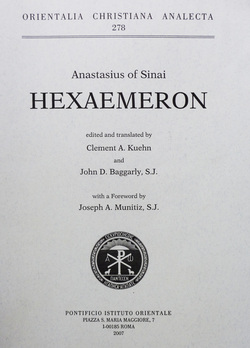THE CREATION PROJECT
The Hexaemeron, written in Greek by Anastasios of Sinai in the second half of the seventh century, first appeared in print in 1579. This was a Latin translation by Gentian Hervet of Books I-XI. Book XII was not printed until 1682, when Pierre Allix published a Greek text that had been edited and translated into Latin by André Dacier. Then in 1865 Jacques-Paul Migne printed the Latin translation of Books I-XI by Hervet (with numerous changes) and the Greek and Latin of Book XII in volume 89 of his Patrologiae Cursus Completus, Series Graeca. The complete Greek text of Books I-XII did not appear in print until 2007. This edition, by Clement Kuehn and John Baggarly, S.J., was a collation of three important Greek manuscripts and was accompanied by an apparatus of variants and an apparatus of biblical sources. This editio princeps also included an English translation, an introduction to the Hexaemeron manuscripts, the history of its scholarship, and an index of important names appearing in the text.
More than two dozen manuscripts of the Hexaemeron have survived, in four distinct families and fragments of a fifth. Thus the 2007 editio princeps was only a first step toward a definitive edition. The Creation Project is endeavoring to provide a comprehensive critical apparatus, a more literal English translation, and a commentary. This is an enormous undertaking not only because of the numerous manuscripts but also because of the considerable length of the Anastasian text, the complexity of the Byzantine writing style, and the difficulty of the subject matter. The Hexaemeron also incorporates Classical Greek, Neoplatonic, and Roman philosophers on the subject of cosmogony; quotations and paraphrases from a wide variety of Church Fathers; Christology; Apologetics; Allegory; and biblical text analysis.
The 2007 edition of the Greek text arose from the collation of three manuscripts: M, N, and P, representing Families IV, I, and II (in that order). The Editio Maior includes variants from the same three manuscripts plus variants from the three branches of Family III, represented by F, m, and S. Variants found in the 1579 Latin translation by Hervet, which are closely related to m, are also included in the collation (Hv). Please note, however, that variants found in the Latin translation published in Migne, which includes changes to Hervet’s, have not been included. For more information on the Greek manuscripts, please see the Manuscript page of this site and the Kuehn/Baggarly 2007 edition. The Editio Maior will be followed by a revised English translation, comprehensive commentary, and updated bibliography.
Editio Princeps
Clement Kuehn and John Baggarly, S.J., eds. and trans., Anastasius of Sinai: Hexaemeron (Orientalia Christiana Analecta 278), (Rome 2007). To order a copy of this edition or to do an on-line word search of its content, please see below.
To order a softcover copy of the complete first edition of the Greek text (OCA 278), with translation and introduction, submit an order here:
a. Amazon.com or Amazon.com.uk or
b. Edizioni Orientalia Christiana of the Pontifical Oriental Institute. The complete Orientalia Christiana Analecta catalog can be viewed at: Orient. Chr. Analecta.
Electronic Text
To view the first edition of the Greek text on-line and/or to do a word search, please visit Thesaurus Linguae Graecae (TLG). Search for Anastasius Sinaïta Theol. {2896}. Subscription is required.
Corrigenda to the Greek Text
To download a list of the corrigenda (compiled by Thesaurus Linguae Graecae) for the OCA 278 edition, please click on the link below. Many thanks for the addition to the corrigenda by Marie-Hélèn Congourdeau, Revue des Études Byzantines 68 (2010): 259-260.
| |||||||

